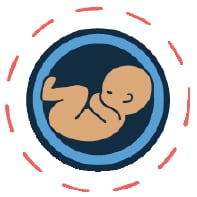Division of Reproductive Health At A Glance

For over 50 years, CDC’s Division of Reproductive Health (DRH) has developed programs to improve women’s health, improve pregnancy health and care, and give infants the healthiest start in life. Multiple surveillance systems and activities in DRH provide information and data that help scientists and health professionals understand how to deliver the best care. These efforts are the foundation of a public health approach to achieve health equity by addressing the drivers of health disparities.
What We Do

In the United States, leading health concerns for pregnant women and their infants are severe and sometimes fatal pregnancy complications, premature births, and sudden unexpected infant deaths. With an FY 2021 budget of $63 million, DRH works to reduce the risk and improve the health of women across their life span. To meet these goals, DRH:
- Measures health behaviors and outcomes before, during, and after pregnancy.
- Studies the drivers of health disparities and interventions to find out what works best to improve maternal and infant health.
- Improves the quality of care for mothers and infants.
- Shares information to reduce risks during pregnancy and the infant’s first year.
Why We Do It
Each year in the United States:

700 WOMEN
die of pregnancy-related causes.

50,000 WOMEN
have severe pregnancy complications.

1 IN 10 INFANTS
(about 380,000) is born prematurely.

3,400 INFANTS
are lost to sudden unexpected infant death.
How We Do It
About 700 women die each year in the United States from complications of pregnancy. Black and American Indian/Alaska Native women are 2 to 3 times more likely to die from these complications than White women. More and better data can help us understand how to prevent pregnancy-related deaths, ensure the best possible birth outcomes, and work to achieve equity.
CDC’s Pregnancy Mortality Surveillance System conducts national surveillance of pregnancy-related deaths in the United States. The Enhancing Reviews and Surveillance to Eliminate Maternal Mortality (ERASE MM) program supports agencies and organizations that coordinate and manage Maternal Mortality Review Committees (MMRCs).
MMRCs are multidisciplinary committees in states and cities that perform comprehensive reviews of deaths among women during and within a year of the end of a pregnancy. Data from MMRCs provide a deeper understanding of the circumstances surrounding each death to guide recommendations at the patient, provider, facility, system, and community level for preventing future deaths.
The Maternal Mortality Review Information Application (MMRIA) is a data system that provides a standardized approach to collect information, review deaths, and analyze data across MMRCs. MMRIA contains fields for different causes and contributing factors, including racism or discrimination. CDC is partnering with the National Indian Health Board to help tribes and tribal organizations design and set up tribally led MMRCs.
CDC’s HEAR HER campaign raises awareness of potentially life-threatening warning signs during and in the first year after pregnancy. HEAR HER encourages the people supporting a pregnant or postpartum woman to really listen and take action when she expresses concerns. The campaign is available in English and Spanish and features personal stories from women who had a serious pregnancy-related complication, including Olympic athlete Allyson Felix.
The campaign includes a variety of downloadable resources, such as an Urgent Maternal Warning Signs Poster in English and 16 other languages. Since the launch of the campaign in August 2020, over 208 million people saw HEAR HER content.
Examples of Our Impact
- Findings from 14 state MMRCs showed that causes of pregnancy-related death varied by race and ethnicity and that 2 in 3 deaths were preventable.
- Tennessee used MMRIA data to develop an infographic on maternal mortality and substance use. The state also used the data to guide efforts to improve access to postpartum care and prevent deaths from substance use disorder.

CDC’s Perinatal Quality Collaboratives (PQCs) are state or multistate networks of health care teams working to improve the quality of care for mothers and infants. They do so by advancing best practices in the health care setting and expanding successful interventions statewide. These efforts have contributed to important improvements in health care delivery and perinatal outcomes.
CDC supports 13 state PQCs and funds the National Network of Perinatal Quality Collaboratives. This network provides support, mentoring, and resources for all PQCs to identify and share best practices and develop tools and training. Nearly every US state has a PQC or is developing one.
CDC has also hosted webinars to share strategies and information about specific PQC initiatives. In addition, the agency helped create a resource guide [PDF – 566 KB] to advance the work of state PQCs. This guide provides information on quality improvement methods and sustainability and explains how to start a statewide collaborative and launch initiatives.
Examples of Our Impact
- The Illinois PQC improved timely treatment for women with severe high blood pressure In the first year of the project, the percentage of patients treated within 60 minutes rose from 41% at baseline to 79%.
- North Carolina’s PQC led a national initiative to reduce central line-associated bloodstream infections in neonatal intensive care units (NICUs). In 11 months, the rate of infections at 100 NICUs in 9 states dropped by almost 60%. The project prevented an estimated 131 infections, which helped prevent an estimated 14 to 41 infant deaths and save more than $2.2 million.
The Pregnancy Risk Assessment Monitoring System (PRAMS) has been a critical source of data on maternal and infant health for more than 30 years. Currently, 50 sites, including 46 states, the District of Columbia, New York City, Puerto Rico, and the Commonwealth of the Northern Mariana Islands, participate in PRAMS.
PRAMS collects jurisdiction-based population data on maternal attitudes, experiences, and health before, during, and shortly after pregnancy. These data are used to guide public health action and provide insights into which efforts can best support new initiatives to improve maternal and infant health.
For example, starting in 2019, PRAMS helped researchers collect data on disabilities among women who have had a recent live birth. Information gathered through PRAMS can be used to guide the development of clinical practices guidelines and programs to improve services and the health of women of reproductive age living with disability.
Examples of Our Impact
- Rhode Island used PRAMS data to develop an issue brief [PDF – 232kb] on maternal depression. The state’s health department used this brief to make the case for helping health care providers screen and treat pregnant and postpartum women with behavioral health conditions and received funding to do this work.
- PRAMS data in Virginia showed that only 1 in 4 Medicaid recipients reported seeing a dentist during pregnancy. In response, Virginia’s governor issued an executive order to fund dental coverage for all pregnant women covered by Medicaid. As a result, more than 14,000 pregnant women in Virginia received covered dental services they would not have otherwise.
Mothers with opioid use disorder (OUD) are at risk of opioid-related overdoses, and their infants can be born with breathing and feeding problems. According to a recent publication, the percentage of mothers with opioid-related diagnoses documented at delivery increased by 131% from 2010 to 2017. The percentage of infants born with neonatal abstinence syndrome (NAS) increased by 82%.
As part of its five-point strategy to prevent opioid overdoses and harms, CDC is working to improve services and programs for pregnant and postpartum women and their infants affected by OUD. CDC is addressing OUD during and after pregnancy by assessing maternal opioid use and working to help states and communities respond effectively. These efforts include:
- Collecting and sharing data on nonfatal opioid use during pregnancy in 32 states through PRAMS.
- Improving and standardizing data on overdose deaths during pregnancy.
- Supporting state teams to address opioid use among women during pregnancy and the postpartum period.
- Improving identification and care of infants with NAS among state PQCs.
Examples of Our Impact
- Researchers looked at data from PRAMS and two state other surveys on self-reported prescription opioid use during pregnancy. The resulting MMWR Vital Signs report shows the need for better counseling and screening for opioid use and misuse in pregnant patients.
- CDC provided funds to implement the Opioid Use Disorder, Maternal Outcomes, and Neonatal Abstinence Syndrome Initiative, which supports state teams to address opioid use among women during pregnancy and the postpartum period. This initiative recommends policies and programs that focus on identifying and treating pregnant and postpartum women with substance use disorder and infants born with NAS.

Sudden unexpected infant death (SUID) is a term used to describe the sudden and unexpected death of an infant less than 1 year old in which the cause was not clear before investigation. These deaths often happen while the infant was sleeping in an unsafe sleep environment. Every year in the United States, about 3,400 infants are lost to SUID.
CDC supports surveillance programs in 22 areas of the country, which covers about 30% of all SUID cases in the United States. The SUID and Sudden Death in the Young (SDY) Case Registry standardizes and improves data collected at death scenes and promotes consistent reporting and classification of SUID and SDY cases. A better understanding of the circumstances and events associated with SUID and sleep-related infant deaths may help reduce future deaths.
CDC publishes materials to help parents and doctors learn how to reduce the risk of SUID. The agency also works on the Safe to Sleep® campaign with the Eunice Kennedy Shriver National Institute of Child Health and Human Development at the National Institutes of Health. The campaign promotes safe sleep recommendations from the American Academy of Pediatrics.
Examples of Our Impact
- Using its SUID Case Registry data as a guide, the Tennessee Department of Health worked with Evidence Based Home Visiting Programs to teach all families receiving home visits or care coordination services about safe sleep and to give them necessary resources. Since these efforts began, the state has reported a 1-year decline in the number of sleep-related infant deaths.
- As a result of the Kentucky SUID Case Registry’s collaboration with the Kentucky Health Access Nurturing Development Services (HANDS) program, HANDS home visitors educate families about safe sleep and provide resources to help them follow the recommended practices. After 1 year, almost 9 in 10 caregivers reported always placing their infant in a safe sleep environment, according to HANDS data.
The Challenge
Non-Hispanic Black and American Indian or Alaska Native women are 2 to 3 times more likely to die from pregnancy-related causes than non-Hispanic White women.
CDC’s Approach
CDC is working to enhance the Maternal Mortality Review Information Application system to:
- Document racism or discrimination as contributing factors in a maternal death.
- Add community indicators of social disadvantage.
- Help Maternal Mortality Review Committees diversify their memberships to include nonclinical and community perspectives.
- Collect information from interviews with family and friends of women who have died from pregnancy-related complications to get more information about the circumstances surrounding their death.